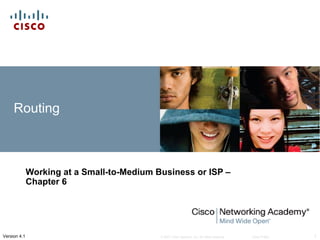More Related Content
Similar to CCNA Discovery 2 - Chapter 6 (20)
More from Irsandi Hasan (20)
CCNA Discovery 2 - Chapter 6
- 1. Routing
Working at a Small-to-Medium Business or ISP –
Chapter 6
Version 4.1 © 2007 Cisco Systems, Inc. All rights reserved. Cisco Public 1
- 2. Objectives
Describe the purpose and function of dynamic routing
and the protocols used to implement it.
Configure RIPv2 dynamic routing using the Cisco
IOS.
Describe the use of exterior routing protocols across
the Internet.
Enable BGP on a customer site router.
© 2007 Cisco Systems, Inc. All rights reserved. Cisco Public 2
- 3. Enabling Routing Protocols
Routing tables contain locally connected
networks
Routers use routing tables to determine routes
Routes can be statically assigned or
dynamically learned through routing protocols
© 2007 Cisco Systems, Inc. All rights reserved. Cisco Public 3
- 4. Enabling Routing Protocols
Components of a route: destination value,
subnet mask, gateway, route cost or metric
© 2007 Cisco Systems, Inc. All rights reserved. Cisco Public 4
- 5. Enabling Routing Protocols
Directly connected routes
Static routes
Dynamically updated routes
Default route
© 2007 Cisco Systems, Inc. All rights reserved. Cisco Public 5
- 6. Enabling Routing Protocols
Static routes are manually configured
Static routes are suitable for small networks
with few changes
© 2007 Cisco Systems, Inc. All rights reserved. Cisco Public 6
- 7. Enabling Routing Protocols
Characteristics of distance vector protocols:
Routers share copies of routing tables
Distance metric can be based on hops, cost,
bandwidth, speed, delay or reliability
Vector is the address of the next hop along a
route
© 2007 Cisco Systems, Inc. All rights reserved. Cisco Public 7
- 8. Enabling Routing Protocols
Routing Information Protocol (RIP):
RFC 1058
Distance vector using hop count metric
Updates every 30 seconds
© 2007 Cisco Systems, Inc. All rights reserved. Cisco Public 8
- 9. Enabling Routing Protocols
Enhanced Interior Gateway Routing Protocol:
(EIGRP)
Enhanced distance vector protocol
Uses a variety of metrics
Cisco-proprietary
© 2007 Cisco Systems, Inc. All rights reserved. Cisco Public 9
- 10. Enabling Routing Protocols
Characteristics of link-state protocols:
Full database of distant routers and
interconnections
Link-state advertisements
Topological database
SPF algorithm
© 2007 Cisco Systems, Inc. All rights reserved. Cisco Public 10
- 11. Enabling Routing Protocols
Open Shortest Path First (OSPF):
Non-proprietary
Link-state
RFC 2328
Advanced protocol
© 2007 Cisco Systems, Inc. All rights reserved. Cisco Public 11
- 12. Enabling Routing Protocols
Criteria for choosing routing protocols:
Ease of management
Ease of configuration
Efficiency
© 2007 Cisco Systems, Inc. All rights reserved. Cisco Public 12
- 13. Enabling Routing Protocols
Describe and implement RIP routing on an
integrated router
© 2007 Cisco Systems, Inc. All rights reserved. Cisco Public 13
- 14. Exterior Routing Protocols
The Internet is divided into autonomous
systems
AS: a set of networks controlled by a single
administration using the same internal routing
policy
Each ISP is an AS
© 2007 Cisco Systems, Inc. All rights reserved. Cisco Public 14
- 15. Exterior Routing Protocols
Interior gateway protocols (IGPs) exchange
routing information within an AS or individual
organization
Exterior gateway protocols (EGPs) exchange
routing information between autonomous
systems
© 2007 Cisco Systems, Inc. All rights reserved. Cisco Public 15
- 16. Exterior Routing Protocols
Each AS uses dedicated border gateway
routers to route packets across the Internet
© 2007 Cisco Systems, Inc. All rights reserved. Cisco Public 16
- 17. Exterior Routing Protocols
ISPs use exterior routing protocols to forward
or control local and/or transit traffic
Exterior protocols enforce policies and support
reliability
© 2007 Cisco Systems, Inc. All rights reserved. Cisco Public 17
- 18. Exterior Routing Protocols
Configuring Border Gateway Protocol (BGP):
Configure the AS number
Identify ISP neighbor router
© 2007 Cisco Systems, Inc. All rights reserved. Cisco Public 18
- 19. Summary
All routers make routing decisions by looking up information stored
in their routing tables.
Routes can be statically assigned by an administrator, or
dynamically learned by the router via a routing protocol.
Routing protocols use either distance-vector or link-state
algorithms to calculate the best routes to each destination.
Criteria such as ease of management, ease of configuration, and
efficiency must be considered when selecting a routing protocol for
use within an organization.
Organizations are also called Autonomous Systems.
Between Autonomous Systems, Exterior Gateway routing
protocols control the flow of traffic.
ISPs handle Internet traffic through the use of routing policies.
© 2007 Cisco Systems, Inc. All rights reserved. Cisco Public 19
- 20. © 2007 Cisco Systems, Inc. All rights reserved. Cisco Public 20

